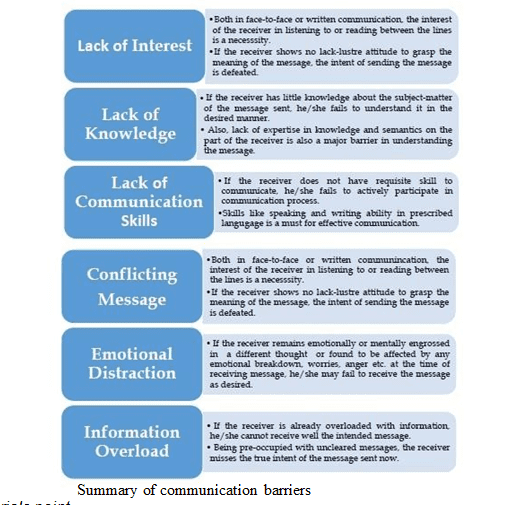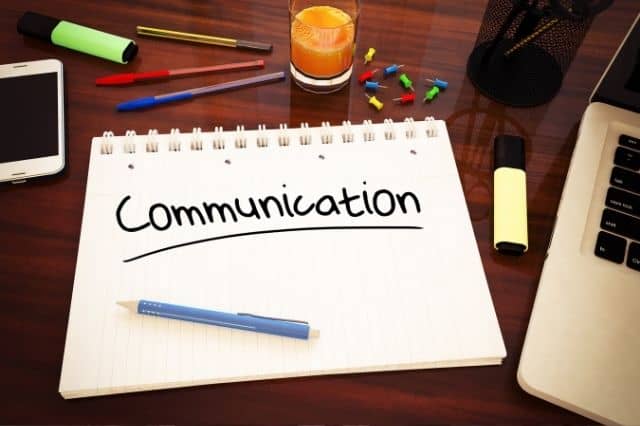Barriers to Effective Communication
The biggest single problem in communication is the illusion that it has taken place. -George Bernard Shaw.
Communication breakdown, communication gap, miscommunication, or failure in communication are common terms that apply to misunderstanding and failure of communication. Why do many people take communication for granted?
This is because they assume it is easy; they have been communicating all their lives. While there may be some truth in this simplistic view, communication sometimes is complex, confusing, and frustrating because of barriers that are introduced along the way.
These barriers are the reasons why communications fail. To eliminate these misunderstandings, it is necessary you understand the most common obstacles to effective communication. What comes to your mind when you hear of barriers to effective communication?
Barriers could be anything that interferes with your ability to easily and clearly construct and express your thoughts or ideas. These obstacles may be intrinsic or extrinsic. They might be physical or emotional; whatever causes hindrance to free flow and expression of ideas constitute a barrier to communication.
Barriers that cause miscommunication are like electrical short-circuit that distort the flow of electrical current. Have you ever experienced an electrical short-circuit? Electrical short circuits can create a bridge, a spark, or a disconnection, thereby hindering the flow of electrical current.
Sometimes, a short circuit can result in a disaster. This is how barriers are to effective communication a short-circuit, disconnection, a spark, or disaster. The barriers to effective communication make communication incomplete, unforceful, ineffective, and imperfect (Alex, 2014: 97).
Read Also: Types or Forms of Communication
Once again, remember that ineffective communication can be very costly to you, your studies, your professional development, or your organization. It is important to remind you that just like you study and learn the essential components of life such as hygiene, good eating habits, good table manners, driving, and right dressing styles, effective communication is consciously learned.
The Barriers to effective communication could be of many types physical, perceptual, linguistic, psychological, emotional, and cultural. Others include information overload, interpersonal barriers, presentation, the medium, and technological barriers. All these types are discussed in detail below.
Physical barriers
Physical barriers constitute one of the major hindrances to effective communication, especially in big organizations. Large multinational companies, banks, and industries understand clearly the effect of the physical obstacles to effective communication.
These organizations operate behind closed doors or in secluded offices which restrict access and affect the movement of messages to and from those that occupy the offices. They operate almost a completely closed-door policy which also closes the door to effective communication.
Physical barriers also include noise, communication equipment failures, closed doors, and physical separation between the sender and receiver (Fiugo, 2012: np).
Information Overload
You will quickly notice that the amount of information generated daily is overwhelming. This leaves you in a state of imbalance where you receive more information than you can process. You receive countless messages everyday advertisements, e-mails, chats, memos, and conversations from those close to you and even from unsolicited quarters.
Schick, Gordon & Haka (1990: 199) argue that ―when information processing demands an individual‘s time to perform interactions, and internal calculations exceed the supply or capacity of time available for such processing‖, information overload results.
There is too much information for an individual to process and absorb. Think of it and recall the myriads of information from television, newspapers, magazines, WhatsApp, IMO, Facebook, and several other unsolicited messages beckoning your attention every day.
This formidable punch of information creates barriers to effective communication. When you are overwhelmed by information overload, you miss out on essential messages; misunderstand several others, and distort quite a lot of others.
Emotional Barriers
Scientific observation shows clearly that emotions play a significant role in effective communication. Mood swings can affect the way you relay or receive messages. People‘s temperaments ranging from choleric, melancholic, phlegmatic, or sanguine moods are known to affect communication.
Sometimes, people wake from the wrong side of the bed, and all through that day, every form of communication is distorted, leading to misunderstanding and failure of communication.
Do you know that the emotional intelligence quotient of senders or receivers influences the ease with which they communicate? Frustration, anger, or humor are emotions that can interfere with the effectiveness of your communication.
It is generally believed that those who are emotionally balanced or mature are more likely to communicate effectively than those who allow their emotions to blow the lid open in the face of unsavory circumstances.
Miscommunication can arise when your ego is up in the high heavens, and you are inconsiderate, intractable, egocentric, and selfish.
Cultural barriers
Communication involves people. People come from different backgrounds with diverse cultures. Cultural diversity affects in one way or the other, interactions, relationships, and communication.
To overcome the barrier of cultural diversity, companies initiate organizational culture where all members are guided by the same rules and regulations that supersede individual peculiarities.
Interpersonal barriers
There are several interpersonal characteristics that may affect how messages are perceived. The manner of interaction and relationship can create barriers in communication.
Interpersonal barriers can take the forms of withdrawal which separate one party from the other or rituals which are meaningless and repetitive routines that create barriers between people.
Read Also: Elements of the Communication Process
The Medium
The medium is the message according to Marshall McLuhan. This underscores the importance of the medium in communication. Defects in the communication devices used for transmitting messages are major barriers to effective communication.
When the communication instruments fail, messages are distorted or incomplete and cause miscommunication, which may lead to unwanted actions. When instruments fail, the communication, presentation, or speech should be rescheduled.
It is better and safer to reschedule a presentation when devices fail than to manage and distort the whole message. The result would be obvious miscommunication.
Perception
People have different levels of perception. Most often, different people see, interpret and understand the same message differently. It is crucial you know this so that your messages can be presented clearly. In communication, you must not forget that we see the world differently.
Individuals’ perceptions and assumptions shape their understanding of the beauties, ugliness, or realities of the world. Examine this anecdote (Alex, 2014: 98), which touches on how perception affects communication:
A traveler was walking down a road when he met a man from the next town. “Excuse me,” he said. “I am hoping to stay in the next town tonight. Can you tell me what the townspeople are like?”
“Well,” said the townsman, “how did you find the people in the last town you visited?” “Oh, they were an irascible bunch. Kept to themselves. Took me for a fool. Overcharged me for what I got. Gave me very poor service.”
“Well, then,” said the townsman, “you will find them pretty much the same here.”
On the other hand, several people select from a message what they want to retain depending on the message, the presenter, and the mode of delivery. Selective perception is a barrier to effective communication. Therefore, present ideas simply and attractively if you want to communicate effectively to the largest audience.
Technological Barriers
In our society today, the effect of technology is commonly seen and felt. The speed of technological development, the new advances, and the cost are factors that may constitute barriers to effective communication.
The application and adoption of technology in any environment are not automatic. It bestows huge responsibilities financially, physically, psychologically, and otherwise on the users. The fear and the thought of how to cross the hurdle create a gully that becomes a crucial barrier that may affect the whole communication process.
Noise
Noise is a major barrier to communication. It is an interference with your message. Noise is anything that interferes with your receiving a message. Noise can distort or prevent the sender‘s message from getting to the receiver. There are four variants of noise in communication (Devito, 2013: 21):
Physical noise is interference that is external to both the source and receiver. This interferes with the physical transmission of the message. Physical noise interferences from cars outside, the humming sound of electronic devices, the short-circuiting of public address systems, misspellings, and poor grammar.
Physiological noise is the barrier embedded in the sender or receiver such as visual impairments, hearing loss, memory loss, and articulation problems, which affects the sender‘s message or what the receiver receives, or both.
Psychological noise is the mental interference in the speaker or listener and includes preconceived ideas, wandering thoughts, biases and prejudices, close-mindedness, and extreme emotionalism. Sometimes, the receiver holds a viewpoint that is built on a wrong premise yet refuses to listen to anything contrary.
The mind is already closed or biased. This kind of noise becomes a bulwark against effective communication.
Semantic noise is interference that occurs when the sender and receiver have language or dialectical differences, especially in the use of terms that have double or more interpretations. This is most prevalent in professional areas that use technical jargon or overly abstract terms like medical doctors.

Language
Differences in language are a major barrier to communication. Have you had to deal with Chinese? He does not understand the English language, and you do not understand Chinese. Just imagine the barrier that will exist between you in trying to relay your messages and vice versa.
Chinese engineers visit Nigeria regularly and it is interesting to witness their interactions with Nigerians. Most often, they communicate using sign language.
This constitutes a barrier to effective communication. Several years ago, in the days of NITEL, a German engineer had a contract with one of the Radio rooms of the NITEL office in Zaria. It was an arduous task relating to Nigerian counterparts.
One of the days, he wanted to end the day‘s work and he said: “Lapitee, I go” which meant he was done for the day and ready to leave the office. Sometimes, the linguistic barriers to effective communication hang on a bushy dialect that may render the communication ineffective.
Closely related to this is the problem of semantics. Meanings are in people and not in words. This means that words can mean different things to different people. The meaning the sender is conveying may be completely different from what the receiver understands.
Sometimes, messages are delivered in highly professional and technical terms that restrict the level of understanding and comprehension of even the experts. Professional jargons are common in several fields, but they constitute obstacles to effective communication.
Read Also: The Need for Effective Communication




